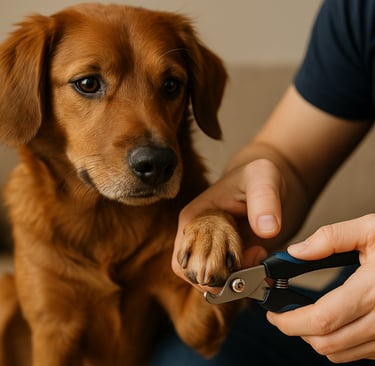Nail It: Why Regular Pawdicures Matter for Your Dog
If you’ve ever heard your dog’s nails clicking across the floor like tiny tap shoes, here’s the truth: it’s not a cute soundtrack, it’s a grooming red flag. Nail care often gets overlooked, but it’s just as important as brushing and bathing. Let’s break down why trimming nails matters, how often to do it, and why leaving it too long can cause more problems than just noisy footsteps.
Lori Cruz
9/22/20251 min read


Why Nail Care Isn’t Optional
• Comfort and posture: Overgrown nails can change how your dog walks, putting stress on joints and causing long-term pain.
• Health risks: Long nails are more likely to split, break, or snag on things (ouch).
• Furniture and floors: Short nails mean fewer scratches on your hardwood, furniture, and — let’s be honest — your legs when your dog says hello.
⸻
How Often Should You Trim?
Every dog is different, but most need trimming every 3–4 weeks.
• Active dogs who walk on pavement may naturally wear their nails down.
• Indoor loungers often need more frequent trims since carpet doesn’t do much filing.
• Dewclaws (the side nails) never touch the ground and always need trimming.
⸻
Tools of the Trade
• Guillotine clippers: Great for small to medium dogs.
• Scissor clippers: Better for large, thick nails.
• Grinders/Dremels: Good for smoothing edges and for dogs who dislike clippers.
⸻
The Struggle Is Real
Most dogs aren’t fans of nail trims. Here are a few tips to make it easier:
• Start young — get puppies used to paw handling early.
• Keep sessions short and positive — treats go a long way.
• If you’re nervous about hitting the quick (the sensitive part of the nail), ask a groomer to show you the ropes.
⸻
The Bottom Line
Regular “pawdicures” keep your dog comfortable, healthy, and happy. Plus, they save your floors and make cuddles a little less scratchy. If trimming nails feels like wrestling an alligator, don’t worry — groomers are pros at making the process quick, safe, and (almost) stress-free.
Contact
Get in touch for all your needs.
About
Services
info@doggiesonwheelsinc.com
1 646-242-8786
© 2025. All rights reserved.
